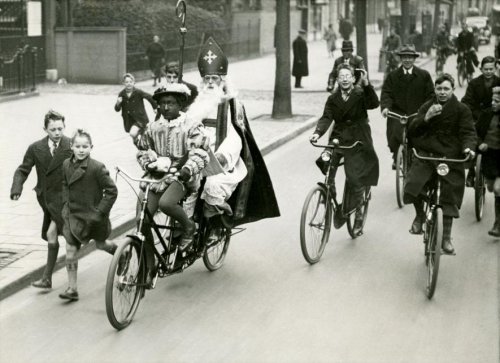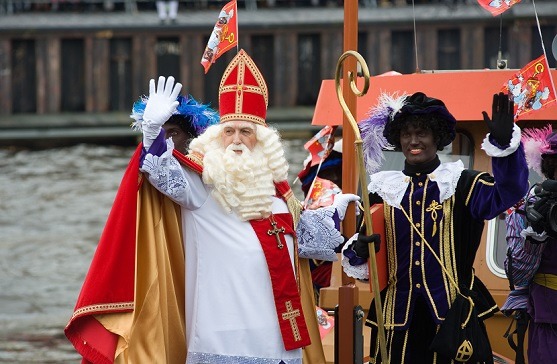It is that time of the year again when St Nicolas rides into towns, villages and cities across Belgium, Netherlands and Luxembourg, spreading festive cheer to the children. But he is never alone. Behind him walks his trusty sidekick, usually a white man, dressed in renaissance clothing donning a curly black wig, red lipstick and a blackened face for the occasion; his name, Zwarte Piet. To many the reference to his race before his Christian name is already offensive, let alone the role he plays as a seemingly compliant companion to St Nick. So does Zwarte Piet or Black Pete have a place in this post-racial society, or should he stay on as one half of a long-held tradition of the Low Countries?
The roots of Black Pete are not exactly clear. Some say he was a Turkish orphan appointed to care for St Nicolas’ horse, Sleipnir, and was actually freed by the Saint. Other historical sources state that he was enslaved and came over from Spain on a steamship. Whatever his origins, the links with slavery are worrying to many, given Belgian’s colonisation in the Congo and the Netherlands’ conduct in Surinam, the Dutch Caribbean, South Africa and Indonesia.
Each year, St Nicolas and Black Pete are seen on or around December 6 bringing good cheer to children in schools across the Benelux, where they are given a royal welcome before the annual handing-out of sweets, chocolates and biscuits to the delighted pupils. However, there have been many raised eyebrows among some – particularly expats – who are newly introduced to the tradition.
Mother of three, Obiageli Onyekpe, is just one of the many who see Black Pete as an abhorrent anachronism. She said: “It is all essentially new to me as an Anglo-African. We are not aware of such nonsense. In the UK we see this as racist and offensive for black people.” She added: “I just don’t get it following St Nicolas around. We don’t see how a painted as a black ‘servant’ would make people happy.”
A similar furore erupted back in the 60s and 70s in Britain involving the Black and White Minstrels shows. The minstrels were white men in blazers who used to blacken their faces, while singing and dancing in front of a studio audience. This activity is now banned in the UK, as it was declared racist and offensive to people of colour. Should the Low Countries follow suit?
Belgian-born Jaak Feuggelen doesn’t think so. He defended his national tradition and argued that those who were not born and brought up in Belgium were missing the point. Mr Feuggelen said: “You cannot judge a culture you have not grown up with. We just don’t have a specific link in our brain which connects Black Pete to racism and slavery, we just don’t.”
Mr Feuggelen, who described himself as having a deep social conscience, added: “People from countries like the UK, I understand, are more sensitive due in part to the UK’s history of slavery in the colonies. But I don’t think we should get rid of our tradition. I think it should be seen as a fun time. I feel the argument is always stretched too far and it is all much ado about nothing. We certainly should not be thinking about getting rid of our cultural heritage. It should be a great time for the children especially, and in my view, we are certainly not laughing at Black Pete”
Ironically, supporters of the tradition and their opponents have recently had one common goal. Members of each of these opposing viewpoints have asked officials responsible for equal opportunities, in both Belgium and the Netherlands, to give their opinion in the Black Pete debate, which many hope will settle the annual dispute once and for all.

St Nicholas and Zwarte Piet riding a bike in Amsterdam, December 3, 1938
There have been calls in the Netherlands for a total ban on Black Pete. Yet, after considering the controversy, the Council of Amsterdam recently declared that he was not a symbol of racism. The argument though has certainly been far from settled. Speaking on behalf of the Netherlands Institute For Human Rights, Marysha Molthoff said that the fundamental issue was to protect school children against discrimination and that her organisation was constantly monitoring schools across the Netherlands to ensure that Pete was depicted as a positive role model. In addition, the ombudsman for children’s rights in Netherlands said they too were constantly scrutinising the issue to protect children from possible discrimination.
Bram Sebrechts, official spokesman for Unia, the Interfederal Centre for Equal Opportunities in Belgium, also said it was important that school children were especially protected against racism. He added the debate was a complex one.
Findings in a report published by Unia showed there were conflicting views across Belgium on Black Pete. There were reports that in some places he was portrayed as a somewhat silly man with red lips and a foreign accent. However, in other instances he was depicted as a funny, acrobatic character: a nice man who gave presents to children. More worrying, there were complaints that he represented a bogeyman who punishes naughty children.
However polarised the viewpoints were, the fundamental argument, according to Mr Sebrechts, was to consider whether the portrayal of Black Pete during the St Nicolas’ festivities was in breach of the anti-discrimination and/or anti-racism law.
Under anti-racism laws in Belgium, Articles 20 and 21 require what is called “specific criminal intent” or putting it another way, an intention to harm, before any action could be taken. Article 12 was also considered as this asks whether – on the basis of colour – anyone is discriminated against and consequently disadvantaged someone because of the nature of the festivities taking place. The presence of Black Pete annually was not deemed to be in breach of any of those articles.
But officials from each of the three Benelux countries stated that the Black Pete debate will always be carefully monitored and managed in order to preserve a child-friendly festival each year on December 6, and they assured that every effort will be made to dispel notions of a stereotype for people of colour, helping to preserve the tradition in the future.
So it seems that Black Pete will be by Saint Nicolas’ side at least for the foreseeable future. The Christmas controversy though, will remain a huge talking point for many years to come.
By Kim Clayton

